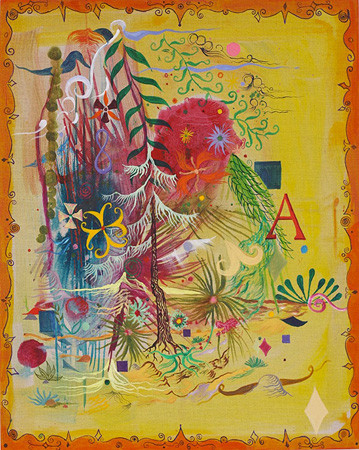Abel Auer
10 Nov - 10 Dec 2011
ABEL AUER
In Zukunft – In the future
10 November – 10 December, 2011
The American philosopher David K. Lewis says that everything we can think of inherently contains the possibility of existence. Abel Auer goes one step further. He constitutes a possible world not only on the intellectual level, he shows it to the viewer in his paintings. The question of whether this world is parallel, alternative or contrary to ours remains unanswered. The unshakable duration of this reality is based on his use of unreal colours, bizarre shapes and distorted perspectives, culminating in the borders of arabesque crochets. In his depictions of nature, Auer interprets the classic, linear perspective. In his portraits he presents, from a conservative and representative angle, strange and distorted faces with indeterminate origin of dream imagery or surrealistic monologues. The boundaries between abstraction and figure, between reality and hallucination, grotesque and seriousness blur. Yet the work is based on the need for formal examination of the construction of the classical language of painting.
Sentimentalism and nostalgia are manifest in his paintings, the longing and the substitute for a lost nature. At once they are personal and reaching to an universal level of human understanding. The figures creeping through fantastic landscapes are reminiscent of heroic characters in the works of Poe, Kafka, Baudelaire or Ensor’s paintings. The strange other-worldliness and unity of the self-contained, hermetic world is drawing the viewer into the narrative, testing his or her sensitivity.
Abel Auer’s images are an exploration of 19th Century landscape painting. They were inspired and influenced by the early visual experiences of the artist, the landscape paintings of his great-grandfather. The motives of his pictures are like archetypes: imaginative, colorful, bright, ecstatic, sometimes on the edge of the bearable. The idyll is turning aggressive. They are dream worlds, parallel worlds, contrary to the artist’s own urban living environment.
In Zukunft – In the future
10 November – 10 December, 2011
The American philosopher David K. Lewis says that everything we can think of inherently contains the possibility of existence. Abel Auer goes one step further. He constitutes a possible world not only on the intellectual level, he shows it to the viewer in his paintings. The question of whether this world is parallel, alternative or contrary to ours remains unanswered. The unshakable duration of this reality is based on his use of unreal colours, bizarre shapes and distorted perspectives, culminating in the borders of arabesque crochets. In his depictions of nature, Auer interprets the classic, linear perspective. In his portraits he presents, from a conservative and representative angle, strange and distorted faces with indeterminate origin of dream imagery or surrealistic monologues. The boundaries between abstraction and figure, between reality and hallucination, grotesque and seriousness blur. Yet the work is based on the need for formal examination of the construction of the classical language of painting.
Sentimentalism and nostalgia are manifest in his paintings, the longing and the substitute for a lost nature. At once they are personal and reaching to an universal level of human understanding. The figures creeping through fantastic landscapes are reminiscent of heroic characters in the works of Poe, Kafka, Baudelaire or Ensor’s paintings. The strange other-worldliness and unity of the self-contained, hermetic world is drawing the viewer into the narrative, testing his or her sensitivity.
Abel Auer’s images are an exploration of 19th Century landscape painting. They were inspired and influenced by the early visual experiences of the artist, the landscape paintings of his great-grandfather. The motives of his pictures are like archetypes: imaginative, colorful, bright, ecstatic, sometimes on the edge of the bearable. The idyll is turning aggressive. They are dream worlds, parallel worlds, contrary to the artist’s own urban living environment.

